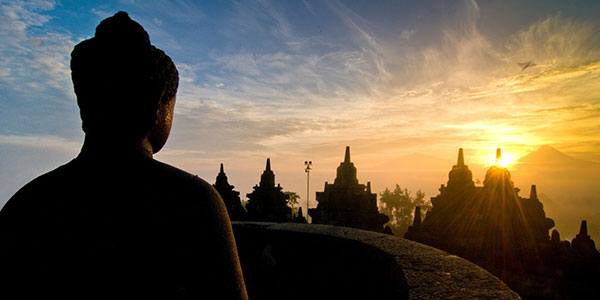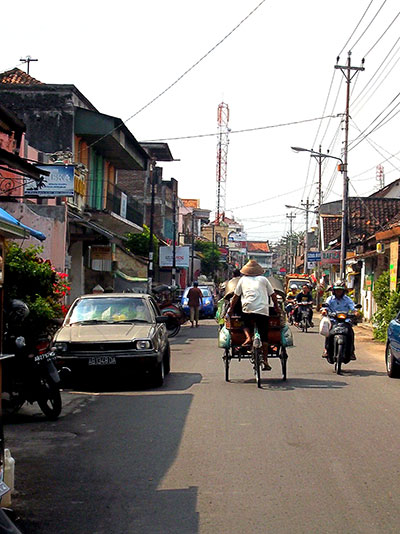
Discover The Volcanoes And Jungle Temples Of Yogyakarta
There’s something about Yogyakarta that inspires affection amongst travellers. Even the city’s nickname, ‘Yogya’ (the actual pronunciation is ‘Jogjakarta’), gives the impression of familiarity, and with good reason – it is the most popular destination for travellers on the island of Java.
As well as the excellent tourist facilities, plentiful budget accommodation options and a variety of places to eat and drink, Yogyakarta also retains a laid-back, welcoming ambience – one that is so often missing in large, bustling Asian cities. Renowned for being the cultural heart of Java with the abundance of handicrafts on offer and close proximity to the magnificent temples of Borobudur and Prambanan, Yogyakarta somehow manages to embrace the modernity of big city life whilst sticking close to its cultural roots. But how long this delicate balance will last is anyone’s guess…

Things To Do In Yogyakarta
Yogyakarta is a treasure trove for the traveller seeking cultural experiences and historical sites with the major draws being the impressive ruins of Borobudur and Prambanan. Most guesthouses offer or will help you find an excursion package for a visit to either of these sights.
Borobudur is situated about an hour’s drive away from Yogya and the most popular time to visit is early in the morning to avoid the oppressive heat of the afternoon sun. Whether you choose to watch the sun rise and enjoy the hushed silence of this awesome jungle temple or pick to arrive just after the event, you may witness the majestic site of active volcano, Mount Merapi, a smouldering silhouette against the lightening sky.

The temple itself is a fascinating glimpse into a long forgotten world. Dating back to the 9th century, Borobudur is one of the largest Buddhist temples in the world and attracts thousands of pilgrims every year. Its narrow corridors boast intricate, detailed carvings relaying the history and teachings of Buddhism whilst over 500 stone Buddhas serenely look on. The uppermost level symbolises enlightenment and delivers an atmospheric experience as the dusky, blue sky brightens over the misty jungle landscape around you.
The temple compound, Prambanan, is the largest Hindu temple in Indonesia, characterised by its huge, pointed spires. An open air and indoor stage has been constructed on the west side of the temple complex to play host to the award-winning, Ramayana Ballet. This magical Javanese dance has been performed for centuries and you can still catch it on-stage on the night of the full moon.

Those that enjoy a spot of hiking should investigate the slopes of Mount Merapi, Indonesia’s most fearsome and active volcano. An eruption in 2010 caused devastation in the foothills – you can explore the ruins at the end of a short trek. If you are interested in a more challenging adventure, sign yourself up to a night climb. Although not compulsory, it is strongly advisable to hire a qualified guide – firstly, to ensure the volcano is safe, and secondly, to help you navigate the route which can prove tricky due to low visibility. The exposed slopes of Merapi can leave you unprotected from the elements so dress accordingly. However, those that complete the climb will be rewarded with stunning views of the sun rising over East Java.

Other places of note in Yogyakarta include the Sonobudoyo Museum with its fascinating and extensive collection of ancient artefacts and Taman Sari, the ruins of the old Sultan’s palace. This pink building housed the royal playground of bathing pools, secret chambers and gardens and is well worth a wander.
Yogyakarta is also well known for its shopping and is just the place to pick up a few souvenirs or gifts for those back home. Javanese batik is the specialist product of the city – choose from printed clothing, homeware and the ever-useful sarongs on offer at the central market place. Just watch out for pickpockets or unwanted ‘guides’ – politely decline their services and ignore them until they go away. In addition, the streets around Kota Gede are a good place to browse for silver jewellery and other silver-ware.
Where To Sleep
In Yogyakarta, there are two main areas that cater exceptionally well to backpackers. Sosrowijan, near Tugu train station, is one and Jalan Prawirotaman, a short becak (cycle rickshaw) ride away, is another. Both areas provide tourist facilities; cheap, cheerful places to eat and drink; and accommodation from budget digs to mid-range rooms.

Bladak Losmen on Sosrowijan offers basic, cheap rooms as well as VIP rooms with amenities such as hot water and TVs – options that work well for the flash-packing crowd. There is also a swimming pool – always a welcome addition in a hot, Asian city.
Where To Eat And Drink
Jalan Prawirotaman has several budget eateries that are worth a visit. Try Via Via, a particular favourite serving a range of western dishes as well as Indonesian fare – ideal for those craving a little taste of home. Warung Heru is also popular due to its super cheap but incredibly tasty Indonesian classics.
After lining your stomach, we recommend dropping into Bintang Bar, about halfway down Sosrowijan, where they frequently host live music shows and you can enjoy a lively, international atmosphere.
For an Indonesian city with real heart and soul, pay Yogyakarta a visit – you might just end up staying longer than you think.
By Alex Saint
